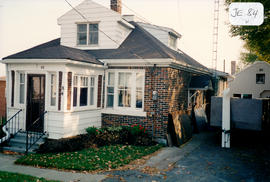- CA BWGPL GJ-HB-2017-04-04-17
- Item
- 1995
Parte de George Jackson fonds
The mid-block building located at 84 John St. East was built around 1920-1930’s in the Ontario Vernacular Cottage style. It was erected on property that was originally owned by Tom Saint and was the site of his storage lot (behind his business on Holland St. East). Tom was a noted stone mason, brick layer, and plasterer. He ran his own business from 1871-1925, at which point his son Leonard took over. A two-storey shed and horse stable (with loft above) stood on this lot originally. There was a 6’ wide and 7’ deep open ditch running from Barrie Street beyond Colborne Street. Tom had a large number of hard cement cloth bags that were used as abutments for a pole bridge. Tiles were eventually laid and the ditch was filled before World War II. The storage property was sold years later.
This 1½-storey, three-bay cottage has a rectangular plan, a centre hall, and a symmetrical façade. A box hall was typical for this style. It has a shallow-pitched, hip roof with dormer windows. The enclosed porch has a hip roof with a raised entrance, a single door opening, and windows on the three exposed sides. Its roof is supported on double, wood half-pilasters that are infilled with brick. There are large windows (with low floor to ceiling heights) to the primary rooms on each side of the porch and double-hung windows at the ground floor. The 2/2 windows appear to be original. They are set into rectangular openings with a brick, rowlock course above and concrete sills. The house has wood frame construction, brick siding and a parged, stone foundation. Aluminum siding is found on the dormers and porch. There is a single, brick masonry chimney at the centre of the house. According to the 2000 inventory, the one-storey rear addition and dormers do not appear to be original because of the style of windows, different roof types, and the shallowness of the main roof pitch. It also notes that some other building elements did appear to be original. (1, 2, 3)
Sem título



